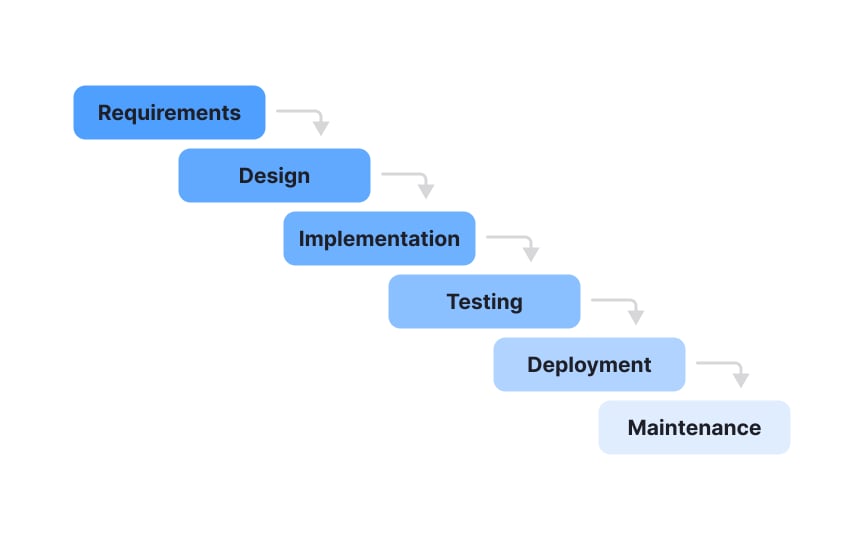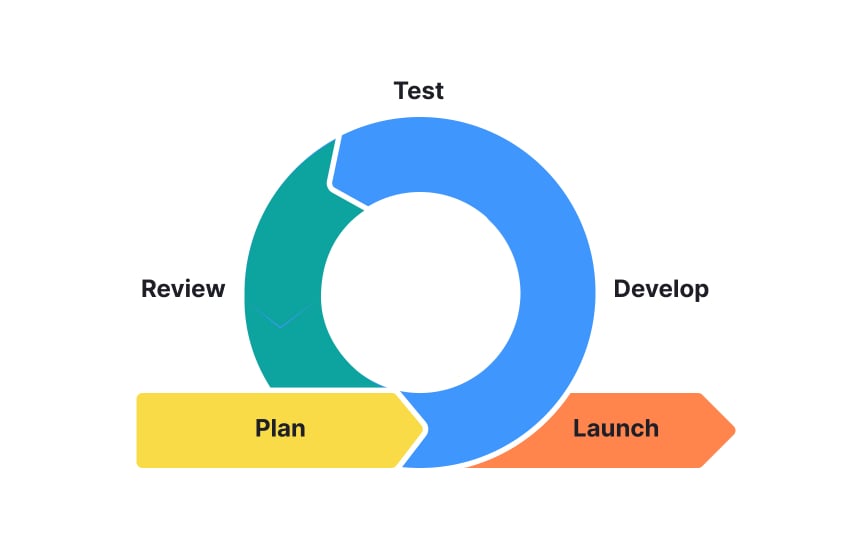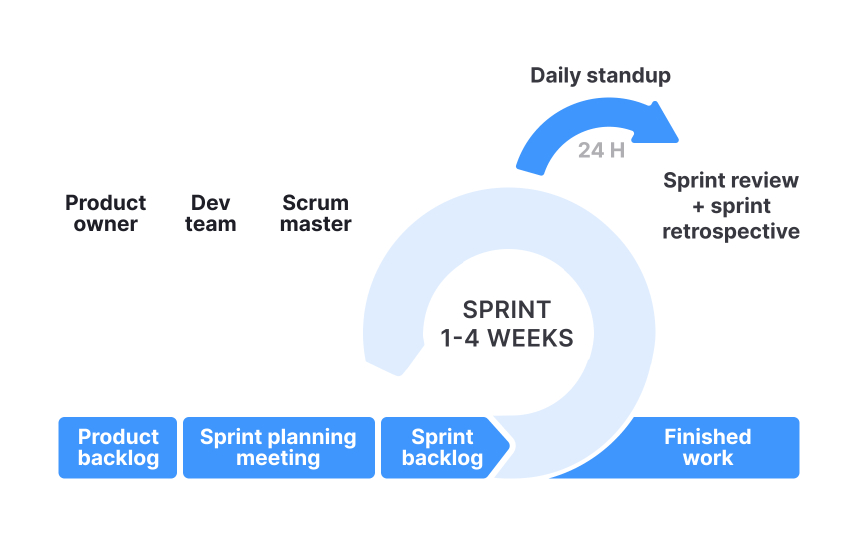Development Methodologies
Ship products faster by picking the right process for your team, not following someone else's playbook
Software teams need structure to build products, manage workflows, and deliver value to users. From traditional Waterfall approaches with sequential phases to adaptive frameworks like Agile and Scrum that embrace change, each methodology offers distinct advantages for different contexts. Modern product teams often blend methodologies, adopting Kanban for continuous flow, Lean principles for waste reduction, or DevOps practices for faster deployment cycles. Understanding these approaches helps teams choose the right framework for their needs, balancing structure with flexibility. The key isn't finding the perfect methodology but adapting proven practices to match your product's complexity, team dynamics, and market demands while maintaining focus on delivering user value consistently.
Waterfall methodology follows a sequential approach where each phase must be completed before the next begins. Requirements gathering, design, implementation, testing, and deployment flow downward like a waterfall.
Traditional industries like construction and manufacturing popularized this approach because changes become costly once execution begins. Software teams adopted Waterfall in the 1970s, bringing structure to chaotic development processes.[1] However, its rigidity often clashes with modern software's need for flexibility.
The methodology excels when requirements are stable and technology is well-understood. Government contracts, infrastructure projects, and safety-critical systems often mandate Waterfall's comprehensive documentation. Each phase produces specific deliverables that stakeholders must approve before proceeding.
The Agile Manifesto, created in 2001 by a group of software developers in Snowbird, Utah, outlines core values and principles for building software in a flexible, collaborative way. It emphasizes individuals and interactions over processes, working software over
Agile methodology breaks product development into short iterations called sprints, typically 1-4 weeks, where teams deliver working features users can actually use. Unlike traditional approaches that spend months planning before building, Agile teams start delivering value within weeks. Each iteration includes planning, development, testing, review, and release in a complete cycle.
Cross-functional teams work together throughout each iteration, eliminating handoffs between departments. Developers, designers, and product managers collaborate daily instead of working in isolation. This approach catches misunderstandings early and ensures everyone shares the same vision for what they're building.
Continuous feedback drives Agile development through regular demos, user testing, and metrics analysis. Teams show working software to stakeholders every iteration, gathering input to shape future work. This rapid feedback loop helps products evolve based on real user needs rather than assumptions made months earlier.[3]
Scrum provides a structured framework for implementing Agile principles through defined roles, events, and artifacts. Product owners manage the product backlog and prioritize features based on business value. Scrum masters facilitate ceremonies and remove impediments while development teams deliver potentially shippable increments.
The framework operates in time-boxed iterations called sprints, typically lasting two to four weeks. Each sprint begins with planning, includes daily standups for coordination, and ends with review and retrospective meetings. This rhythm creates predictability while maintaining flexibility to adapt.
These 3 artifacts make work transparent:
- The product backlog contains all desired features
- The sprint backlog shows current sprint commitments
- The increment represents completed work
Pro Tip: The product manager and product owner should be the same person in a Scrum team. The PM acts as product owner on the team but still handles all broader PM responsibilities like strategy and stakeholder alignment.
Kanban visualizes work as it flows through different stages, helping teams identify bottlenecks and optimize their process. Originally developed by Toyota for manufacturing, this method uses boards with columns representing workflow stages.[4] The board shows tasks as they move from "To Do" to "Done" with columns for each step in the process.
The methodology emphasizes limiting work in progress (WIP) to prevent overload and maintain quality. When teams constrain how many items can exist in each column, they create pull systems where new work begins only when capacity exists. This approach reduces multitasking and improves delivery predictability.
Kanban's flexibility makes it ideal for teams handling varying work types or unpredictable demands. Unlike Scrum's fixed sprints, Kanban allows continuous flow where items start and finish independently. Teams can implement Kanban gradually without disrupting existing processes.
Sprint planning in a Scrum is the meeting where the team decides what to work on in the next sprint. The product owner must be ready before the meeting with prioritized
The team then selects backlog items that support this goal and breaks them into smaller tasks. They estimate how much effort is needed using simple methods like story points or planning poker. This helps avoid overcommitment and keeps the pace sustainable.
By the end of the session, the team has two things: a sprint goal and a
A product
There are different ways to prioritize. For example, the MoSCoW method groups items into Must have, Should have, Could have, and Won’t have. A value vs. effort matrix shows which tasks bring the most value with the least effort, helping teams find quick wins. Weighted scoring models are useful when decisions involve many factors.[5]
A healthy backlog mixes new features, bug fixes, improvements, and technical debt. It should not grow endlessly. Items that stay unprioritized for too long should be archived or removed. This keeps the backlog focused on creating near-term value and prevents wasted effort.
Daily standups create rhythm and transparency by having team members share progress, plans, and impediments. These 15-minute timeboxed meetings happen at the same time and place each day. Participants typically answer 3 questions: what they did yesterday, what they'll do today, and what's blocking them.
Effective standups focus on coordination rather than status reporting. Teams should discuss how their work affects others and identify collaboration opportunities. The goal is synchronization, not detailed problem-solving.
Beyond standups, regular ceremonies like sprint reviews, retrospectives, product
Retrospectives in Scrum close each sprint by reflecting on what went well, what didn't, and what to improve. This ceremony creates psychological safety where teams can discuss challenges openly without blame. Effective retrospectives lead to concrete action items that teams implement in subsequent sprints.
There are different ways to run retrospectives. One method is Start-Stop-Continue, where the team lists things to start doing, stop doing, and continue doing. Another method is the Sailboat exercise, where the team identifies what helps them move forward (winds) and what slows them down (anchors). Using different formats keeps meetings fresh and helps the team notice new issues or opportunities for improvement.
Continuous improvement requires tracking action items and measuring their impact. Teams should limit improvements to one or two per sprint to ensure follow-through. Regular retrospectives compound small improvements into significant transformations over time.
DevOps is about getting development and operations teams to work together instead of separately. Both teams share responsibility for delivering the product. DevOps focuses on automation and using continuous integration and continuous deployment (CI/CD) to make delivery faster and more reliable.
Continuous integration (CI) means developers merge their code often. Each merge triggers automated builds and tests. This helps catch problems early when they are easier to fix. Continuous deployment (CD) takes this further by automatically moving code from testing to production, allowing multiple releases in a single day if needed.
Other important
Similar lessons

Continuous Discovery Mindset

Business Outcomes vs. Product Outcomes






















